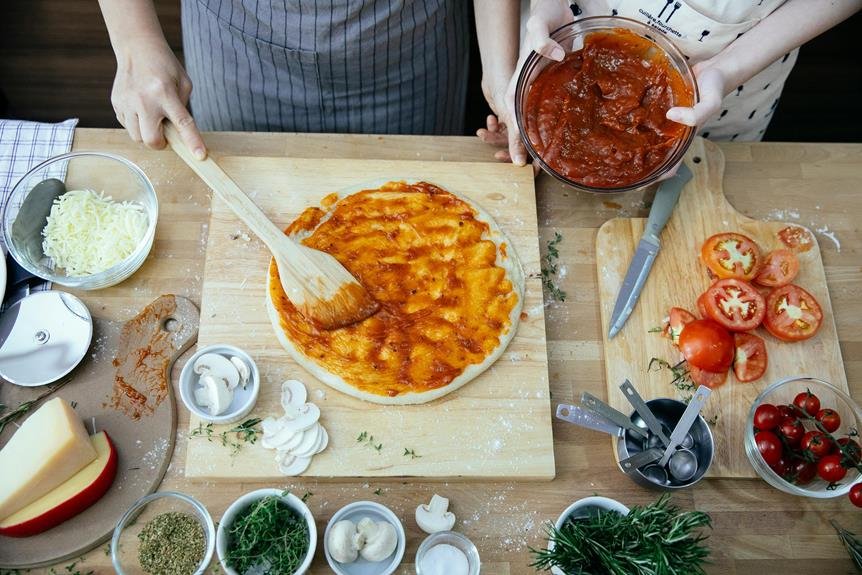
When it comes to crafting the ideal homemade pizza dough, mastering the art lies in a few key steps. From selecting the finest ingredients to understanding the nuances of kneading and rising, the journey to perfection is both rewarding and precise. By unraveling the secrets behind dough consistency and mastering the techniques that elevate your crust to the next level, you can elevate your pizza game to new heights. So, are you ready to elevate your pizza-making skills and unlock the secrets to achieving the perfect homemade pizza dough?
Importance of Quality Ingredients
When making perfect homemade pizza dough, using high-quality ingredients is essential for achieving the best flavor and texture. The foundation of any great pizza dough lies in the ingredients you choose. Start with a good quality bread flour, as it has a higher protein content that will give your dough the perfect chewiness and structure. Opt for fine sea salt for its purity and ability to enhance the overall taste of the dough. Fresh yeast or active dry yeast is crucial for the dough to rise properly and develop those airy pockets that make a pizza crust light and delicious.
Investing in extra-virgin olive oil won't only add richness but also contribute to the dough's tenderness. When it comes to water, using filtered or bottled water can make a noticeable difference in the final taste of your pizza crust. Remember, the quality of your ingredients sets the foundation for a mouthwatering homemade pizza experience.
Step-by-Step Mixing Instructions
To begin mixing your pizza dough, gather all your ingredients and equipment on a clean work surface. Start by combining your flour, yeast, salt, and sugar in a mixing bowl. Make a well in the center and pour in your warm water and olive oil. Using a wooden spoon or your hands, mix the ingredients until a rough dough forms.
Once the ingredients are roughly combined, it's time to knead the dough. Lightly flour your work surface and transfer the dough onto it. Knead the dough for about 10-15 minutes until it becomes smooth and elastic. If the dough is too sticky, gradually add more flour. If it's too dry, sprinkle a little water.
After kneading, shape the dough into a ball and place it in a lightly oiled bowl. Cover the bowl with a damp towel or plastic wrap and let the dough rise in a warm, draft-free place until it doubles in size.
Now your pizza dough is ready to be rolled out and topped with your favorite ingredients before baking to perfection.
Tips for Perfect Dough Consistency
For achieving perfect dough consistency, focus on adjusting the flour and water ratio until a smooth and elastic texture is achieved. The key to achieving the ideal consistency lies in gradually adding water to the flour mixture. Start by incorporating most of the flour into the water and then adjust by adding small amounts of flour or water as needed. Kneading the dough thoroughly is crucial to develop gluten, which gives the dough its elasticity. Aim for a dough that's tacky but not overly sticky – it should easily pull away from the sides of the bowl.
To test if the dough has reached the desired consistency, perform the windowpane test. Take a small piece of dough and gently stretch it out. If it forms a thin, translucent membrane without tearing, the dough is ready. Remember that factors like humidity can affect dough consistency, so be prepared to make small adjustments during the mixing process. Mastering the perfect dough consistency is key to achieving a delicious homemade pizza crust.
Proper Dough Rising Techniques
Achieve optimal dough rising by allowing the dough to rest in a warm environment until it doubles in size. This crucial step ensures that your pizza dough will be light and airy, resulting in a perfect crust. To facilitate the rising process, cover the dough with a damp cloth or plastic wrap to keep it from drying out. Placing the dough in a greased bowl and turning it over once will help coat it with oil, preventing a crust from forming on the surface. Be patient during the rising phase, as rushing this step can impact the texture and flavor of your pizza crust.
When choosing a location for your dough to rise, aim for a warm spot free from drafts. A temperature of around 75-85°F (24-29°C) is ideal for yeast activation and dough expansion. If your kitchen is on the colder side, you can create a warm environment by preheating your oven slightly, turning it off, and then placing the dough inside to rise. By following these proper dough rising techniques, you'll be on your way to creating the perfect homemade pizza crust.




